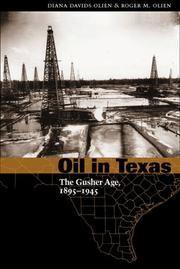| Listing 1 - 5 of 5 |
Sort by
|
Book
ISBN: 0875656943 9780875656946 9780875656854 Year: 2018 Publisher: Fort Worth, Texas : TCU Press,
Abstract | Keywords | Export | Availability | Bookmark
 Loading...
Loading...Choose an application
- Reference Manager
- EndNote
- RefWorks (Direct export to RefWorks)
Shale Boom: The Barnett Shale Boom in North Texas is a study of the opening up of the Barnett Shale to enormous gas production and how that led to an urban gas drilling boom in the Fort Worth metroplex.
Petroleum industry and trade --- Shale gas industry --- Gas well drilling --- Oil wells --- Gas wells --- Shale gas reservoirs --- Natural gas wells --- Wells, Gas --- Gas shale plays --- Plays, Gas Shale --- Plays, Shale gas --- Shale gas plays --- Gas reservoirs --- Oil-shales --- Wells, Oil --- Oil fields --- Petroleum engineering --- Drilling, Gas well --- Natural gas well drilling --- Well drilling, Gas --- Boring --- Gas industry --- Energy industries --- Oil industries --- Social aspects --- Environmental aspects --- Hydraulic fracturing
Book
ISBN: 9798890871206 0807874906 Year: 2000 Publisher: Chapel Hill : University of North Carolina Press,
Abstract | Keywords | Export | Availability | Bookmark
 Loading...
Loading...Choose an application
- Reference Manager
- EndNote
- RefWorks (Direct export to RefWorks)
Petroleum industry and trade --- Public interest --- Public opinion --- Moral and ethical aspects --- Historiography. --- Government policy --- Public opinion. --- Rockefeller, John D. --- Standard Oil Company

ISBN: 0292798555 0292760566 Year: 2002 Publisher: Austin : University of Texas Press,
Abstract | Keywords | Export | Availability | Bookmark
 Loading...
Loading...Choose an application
- Reference Manager
- EndNote
- RefWorks (Direct export to RefWorks)
As the twentieth century began, oil in Texas was easy to find, but the quantities were too small to attract industrial capital and production. Then, on January 10, 1901, the Spindletop gusher blew in. Over the next fifty years, oil transformed Texas, creating a booming economy that built cities, attracted out-of-state workers and companies, funded schools and universities, and generated wealth that raised the overall standard of living—even for blue-collar workers. No other twentieth-century development had a more profound effect upon the state. In this book, Roger M. Olien and Diana Davids Hinton chronicle the explosive growth of the Texas oil industry from the first commercial production at Corsicana in the 1890s through the vital role of Texas oil in World War II. Using both archival records and oral histories, they follow the wildcatters and the gushers as the oil industry spread into almost every region of the state. The authors trace the development of many branches of the petroleum industry—pipelines, refining, petrochemicals, and natural gas. They also explore how overproduction and volatile prices led to increasing regulation and gave broad regulatory powers to the Texas Railroad Commission.
Petroleum industry and trade --- Petroleum engineering --- Oil wells --- History.
Book
ISBN: 9780292798557 0292798555 Year: 2002 Publisher: Austin : University of Texas Press,
Abstract | Keywords | Export | Availability | Bookmark
 Loading...
Loading...Choose an application
- Reference Manager
- EndNote
- RefWorks (Direct export to RefWorks)
As the twentieth century began, oil in Texas was easy to find, but the quantities were too small to attract industrial capital and production. Then, on January 10, 1901, the Spindletop gusher blew in. Over the next fifty years, oil transformed Texas, creating a booming economy that built cities, attracted out-of-state workers and companies, funded schools and universities, and generated wealth that raised the overall standard of living—even for blue-collar workers. No other twentieth-century development had a more profound effect upon the state. In this book, Roger M. Olien and Diana Davids Hinton chronicle the explosive growth of the Texas oil industry from the first commercial production at Corsicana in the 1890s through the vital role of Texas oil in World War II. Using both archival records and oral histories, they follow the wildcatters and the gushers as the oil industry spread into almost every region of the state. The authors trace the development of many branches of the petroleum industry—pipelines, refining, petrochemicals, and natural gas. They also explore how overproduction and volatile prices led to increasing regulation and gave broad regulatory powers to the Texas Railroad Commission.
Petroleum industry and trade --- Petroleum engineering --- Oil wells --- History. --- History. --- History.
Digital
ISBN: 9780292798557 Year: 2021 Publisher: Austin, Tex. University of Texas Press
Abstract | Keywords | Export | Availability | Bookmark
 Loading...
Loading...Choose an application
- Reference Manager
- EndNote
- RefWorks (Direct export to RefWorks)
| Listing 1 - 5 of 5 |
Sort by
|

 Search
Search Feedback
Feedback About UniCat
About UniCat  Help
Help News
News